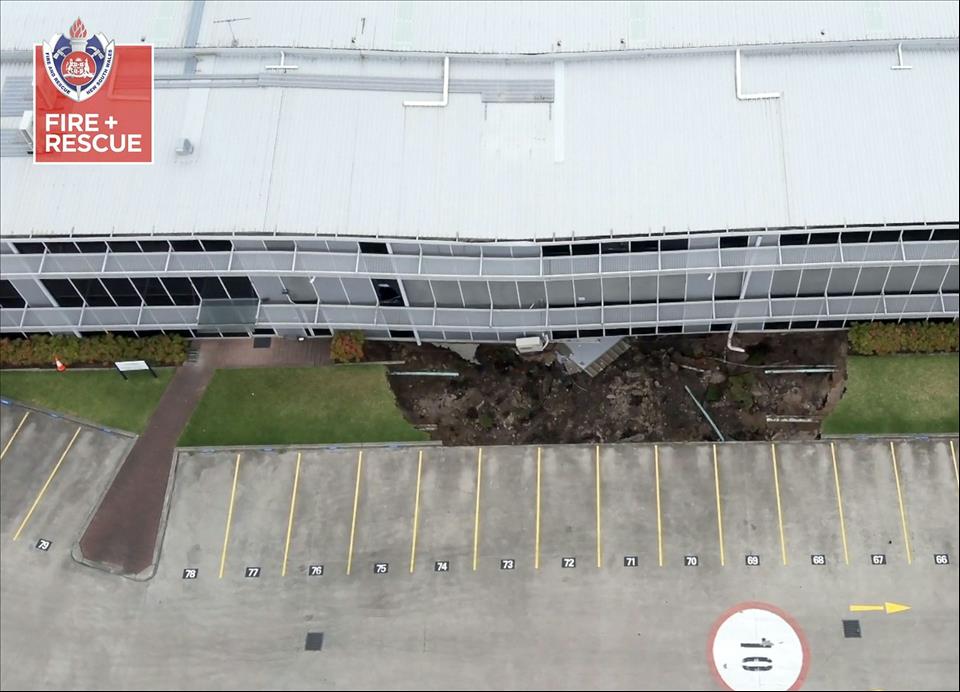
What Is A Sinkhole? A Geotechnical Engineer Explains
Sinkholes aren't uncommon. Two opened up in the Sydney suburb of Rockdale in March, one of which reportedly left a commercial building at risk of collapsing. Another large sinkhole opened up in the South Australian city of Mount Gambier last year.
So, what is a sinkhole and why do they happen?
Read more: Inskip beach collapse: just don't call it a 'sinkhole'
What is a sinkhole?A sinkhole is basically a hole which appears to suddenly open up in the ground. However, the process that leads to a sinkhole is not so sudden and may have been developing over a long period.
Sinkholes happen when a cavity starts to grow underground. It expands over time, but the soil on the surface is strong enough to hold together and form a“ceiling” over the cavity. This ceiling is essential, otherwise you don't have a sinkhole; you just have a hole.
At some point the surface layer becomes too thin or too weak and it collapses under its weight (or, in the Sydney case on the weekend, under the weight of a 13-year-old boy).
When the ceiling collapses you end up with a hole that exposes the cavity previously hidden underground.
If the cavity is deep enough underground and surrounded by strong enough rocks, it may grow and never collapse, eventually forming tunnels and cave systems. In some cases, however, these caves may link up with localised sinkholes at the surface.
So what causes the cavity?Acidic rainwater can degrade underground rock. This can create underground caves which can eventually collapse into sinkholes. Sinkholes of this type need a specific type of geology; you need certain rocks prone to dissolution. It is common in the Middle East and the United States for example.
In Australia, we more commonly see sinkholes emerging due to underground erosion. Here, flowing groundwater carries soil out of the area. The more the cavity opens up underground, the more water gets drawn to it and the higher the chance of a sinkhole. Water flow rate can increase over time, creating a snowball effect heightening the risk of the soil ceiling collapsing.
The sinkhole that appeared in Sydney over the weekend may already have been growing quietly for a while, and could have expanded faster as the weekend's intense rain soaked into the soil. All it took was someone to walk over the top.
Human factors can play a part. For example, a leaking underground pipe can, over time, worsen underground erosion and may increase risk of a sinkhole developing.
Some sinkholes, like this one in Mexico, can get very big. AP Photo/Pablo Spencer How common are they?
They are not uncommon but it's not really possible to say how many are in Australia.
The sinkholes you hear about in the media generally attract attention because they are in a city, so the public are more likely to interact with them and the risk to buildings or people may be greater.
But they can happen everywhere. I have seen them while bush walking just outside of Sydney.
How dangerous are they?Most will not be dangerous as they may be quite small. But until the surface opens, there's no way of knowing there is a sinkhole underground, and it's hard to know from the outside what size cavity sits beneath the surface. You might have a small opening you can see from the surface but a very big cavity underneath.
That can make them dangerous or, at the very least, a problem.
Large sinkholes can happen but small ones are much more common. To get to bigger ones, the cavity ceiling needs to be able to sustain itself for a very long period of time, which is unusual.
But they can get very big. There are some very large sinkholes in Mexico that I discuss in my unit on geotechnical engineering. One has a diameter of about 60 metres.
A 30-metre-wide sinkhole opened up in the Japanese city of Fukuoka in 2016.
Another example of an area prone to sinkholes is Florida, as the carbonate rocks in the ground there are more susceptible being dissolved by water.
A massive sinkhole opened up in the middle of the business district in Fukuoka, southern Japan in 2016. Sadayuki Goto/Kyodo News via AP
So in general, sinkholes are not uncommon but they usually don't get reported unless they are very big or pose a risk to people or property.
My colleagues and I have a grant to study the formation of sinkholes, so we can better understand risk and how to predict where they might happen.
Read more: Why is Australia's east coast copping all this rain right now? An atmospheric scientist explains

Legal Disclaimer:
MENAFN provides the
information “as is” without warranty of any kind. We do not accept
any responsibility or liability for the accuracy, content, images,
videos, licenses, completeness, legality, or reliability of the information
contained in this article. If you have any complaints or copyright
issues related to this article, kindly contact the provider above.
Most popular stories
Market Research

- Primexbt Launches Apple Pay For Seamless Deposits On Mobile
- VUBE Exchange Announces Unified Account Integration Across VUBE Pro, VUBE Plus, And VUBE Max
- Rome Launches Its Genesis NFT Collection“Imperia” On Magic Eden Launchpad
- Cregis At TOKEN2049 Singapore 2025: Unlocking The Next Frontier Of Adoption
- Pepeto Highlights $6.8M Presale Amid Ethereum's Price Moves And Opportunities
- FXIFY Partners With Alchemy Markets To Enable Users To Trade On The Tradingview Platform



















Comments
No comment